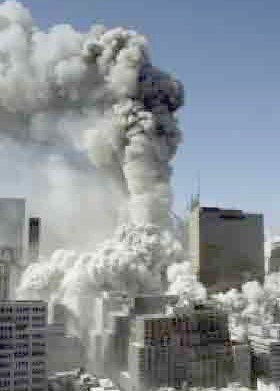
Thomas Ruff, jpeg td02, 2006 © Thomas Ruff
The 1st at Moderna: Thomas Ruff
jpegs
1.3 2007 – 2.5 2007
Stockholm
Together with GIF, JPEG is the most commonly used image format on the internet. It is a lossy compression which means that a compressed image is altered in relation to its original. Saving an image in the JPEG format reduces the size of the file by removing tiny details. The user decides how much to remove. A lower standard of quality makes the image “light”, ensuring a faster transfer speed. For higher quality, the opposite is the case.
Ruff chooses this opposite way – he enlarges the images and the pixels. Pixel size is a unit of measure for height and width, indicating how many pixels are used to render a dot image. In Ruff’s case, it means that if you stand close to an image, it appears to be completely abstract. If you stand further back the subject-matter begins to emerge.
However, I am not specifically interested in the actual technical process. Ruff’s photographs have a wider meaning. In his previous series “Interiors”, “Portraits” and “Houses”, he focused on the everyday. The portraits do not depict people who have made an impact of any kind. Rather, they are characterised by a sense of identity loss and lack of personality. I recall seeing them in the 1993 exhibition “Post Human” at Deichtorhalle, Hamburg. The exhibition questioned the human body as the norm for the natural or the authentic. The people Ruff depicted appeared as empty shells, devoid of everything apart from their appearances.
Ruff emphasises the superficiality of photographs. It is not human beings that are depicted; instead he points to the actual image of human beings. This is also apparent in his series “Newspaper Photos” of the early 1990s. By re-photographing published news pictures, which are often cut for editorial reasons, and presenting them without the captions, he questioned how much information is contained in such images when they are isolated and displayed without a caption.
It seems to me that “Jpegs” continues on this route. Internet is both a treacherous forum and in many ways a fantastic forum. However, the disseminated information can be detached and isolated from its original context. Despite the fact that we seem to be getting closer to each other, independent of geography, age or sex through the interactive character of the forum, paradoxically, the distances also increase. As Andy Warhol and Pat Hackett put it in their 1988 book Andy Warhol’s Party Book: “Sex and parties are the two things that you still have to actually be there for – things that involve you and other people. For sex and parties, you still have to physically bring your lump of protoplasm and get it close to somebody else’s. To carry on friendships or to cash checks or buy clothes, you can just make a phone call or send a computer message. To give court testimony or look for a date or read your own will after you’re dead, you can send a videotape. To impregnate somebody and reproduce yourself, you can just send sperm. You don’t even have to be there to fight a war – you just send a bomb.”
Ruff’s downloaded images of various war zones contain a critique of how the images are used by the media. Instead of emphasising the closeness of the images to their subject, he points to the distance, by enlarging the pixels. We are not looking at “reality” but at a digital reproduction that can be experienced and interpreted in its own right. What do these war zones represent? Certainly, photographs “bear testimony” to an event and as such they can confirm a war crime, for example. But they also risk becoming part of the sensationalist agenda of the mass media.
Introducing a distance to the subjects on both the level of ideas and the purely physical level leads to another issue of interpretation of Ruff’s images. Is it, in fact, Thomas Ruff who commits a crime by aesthetisizing the horrendous content? If that is the case, we as viewers become accomplices, unless we view the images as a critique of the idea of the authenticity of photographs. Didactically, he lets us in on how a constructed and manipulated reality is represented in today’s digital photographs. Paradoxically, however, something else occurs. The difficulty of pinning down the subjects creates a peculiar visual effect. The images resemble mirages and are lent an almost dreamlike or mythological character. Thus he points to the problem of whether mass media images provide us with correct information about a given situation.
Curator: John Peter Nilsson
The 1st at Moderna is an exhibition programme for contemporary art. The opening is always on the first day of the month, and the exhibitions are in different venues in or outside the museum.
